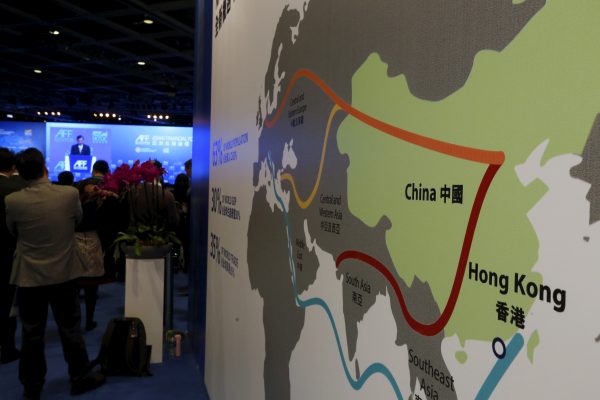The MSR initiative provides a new opportunity for China–ASEAN joint oil and gas developments in the South China Sea. It coincides with a push among ASEAN countries for a maritime development strategy and increased regional connectivity. ASEAN members hope to reach a consensus on joint development in the South China Sea and potentially resolve territorial disputes in the region.
The MSR initiative was first proposed in Indonesia and has the potential to align with President Jokowi’s vision of Indonesia as a global maritime axis. Jokowi hopes that through increasing connectivity between the Pacific and Indian Oceans, Indonesia will become the key player responsible for promoting stability in the region.
The joint statement issued at the end of Jokowi’s March 2015 visit to China suggested that both countries agreed that the MSR and global maritime axis visions were highly complementary. The two countries agreed to work to synergise their mutual maritime interests.
But there are two serious concerns for Southeast Asian countries that might increase China–ASEAN distrust and halt MSR construction.
First, although the South China Sea arbitration case has concluded, the concerns of many Southeast Asian countries regarding China’s nine-dash line have increased. After the ruling of the Permanent Court of Arbitration, China defined the legal meaning of its nine-dash line for the first time, affirming that all islands within this line and all adjacent waters were Chinese sovereign territory. For Vietnam, ‘China’s expanded concept of maritime sovereignty constitutes a serious challenge to Vietnam’s territorial integrity’.
Indonesia also holds that the nine-dash line sweeps through its exclusive economic zone north of the Natuna Islands. For China, the nine-dash line marks the outer limits of its sovereign claims in the South China Sea. But for Indonesia, there is no common sea border or overlap with China. This was made clear in Jakarta’s submission to the UN in 2010 that stated that the nine-dash line ‘clearly lacks international legal status and is tantamount to upset the UNCLOS 1982’. It goes on that ‘Indonesia’s maritime ambitions could hardly be achieved if the South China Sea became a Chinese lake, ruled and regulated by Chinese domestic law, not UNCLOS, and patrolled down to and even beyond the nine-dash line by China’s coast guard and navy’.
Kishore Mahbubani, Dean of Lee Kuan Yew School of Public Policy, has noted that ‘China’s atypical emotional defence of the nine-dash line in the South China Sea goes against its larger global interests’. He believes China has prioritised the region at the expense of its global interests.
Another serious concern in Southeast Asia is whether China is undermining ASEAN unity. In theory, China could afford to alienate the 10 relatively weak ASEAN member states. But in practice, China is assisting ASEAN countries by enhancing infrastructure connectivity in Southeast Asia.
Examples of China–ASEAN disunity include the 45th ASEAN Ministerial Meeting hosted by Cambodia in July 2012, which failed for the first time to issue a joint statement. Cambodia refused to accommodate requests to include references to incidents in the South China Sea in the final communique. In their view, ‘some ASEAN countries national interests are sacrificed to ASEAN solidarity’.
Many railway construction projects and jointly-run industrial park developments under China’s MSR initiative have so far been conducted within a bilateral cooperative framework. This has aroused serious concerns among Southeast Asian nations. Some worry that China has the power to set the terms of the agreements and could then shape the economic and political future of the ASEAN countries. In this sense, the MSR may erode ASEAN unity and undermine its consensus principle.
For China, the construction of the MSR is a primary strategic objective for the time being. Although the MSR is mainly an infrastructure investment and trade initiative, it has strong political and security dimensions. It is in the best interest of every country for Chinese investment and trade to expand. But if consensus cannot be achieved and distrust remains, the initiative could be interpreted as a ‘geopolitical conspiracy’. It is therefore vital for China to cultivate political and strategic relationships with Southeast Asian countries.
To reduce ASEAN security concerns and increase mutual trust, some scholars suggest that China should substantiate its insistence on the nine-dash line and put forward its own roadmap for dispute resolution.
Others suggest that China needs to move from providing economic assistance to providing more security assistance to ASEAN countries. For example, Yan Xuetong of Tsinghua University has suggested that, ‘instead of focusing on the large-scale construction of islands which is of high-cost and low-efficiency, China can provide more military and security assistance to Southeast Asian countries’. This military assistance would enhance regional strategic cooperation and help to increase mutual trust and confidence between China and ASEAN.
Zhao Hong is a visiting Senior Fellow of ISEAS Yusof Ishak Institute, Singapore.

